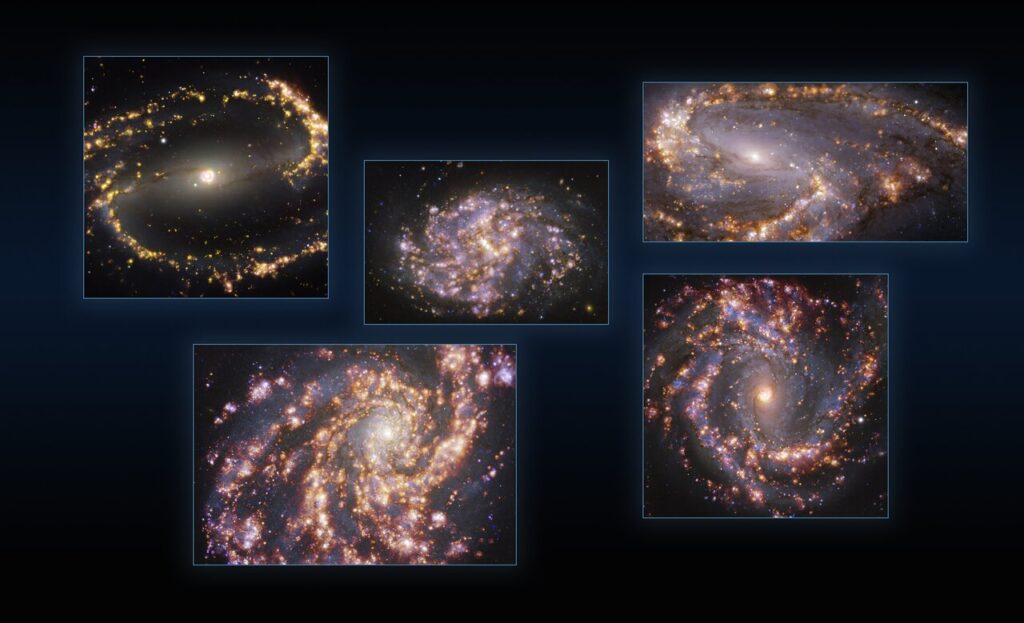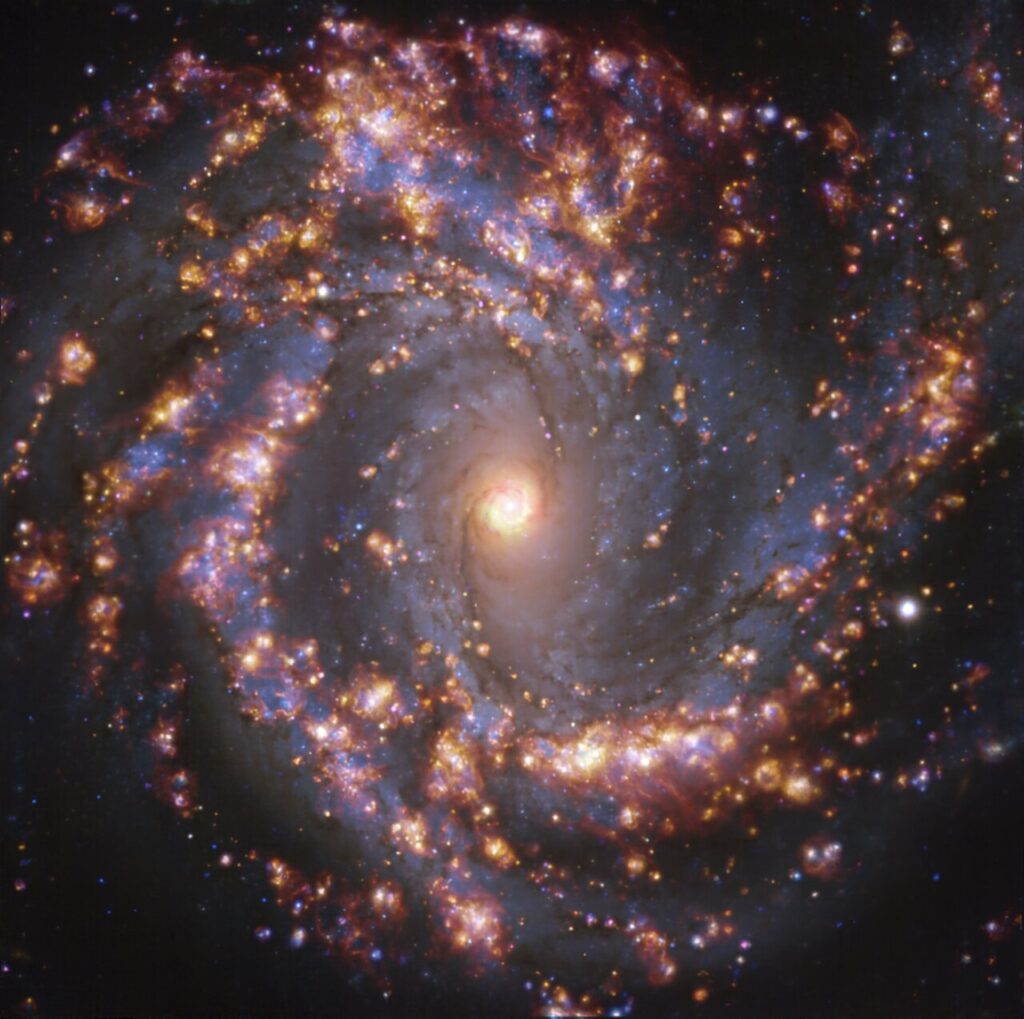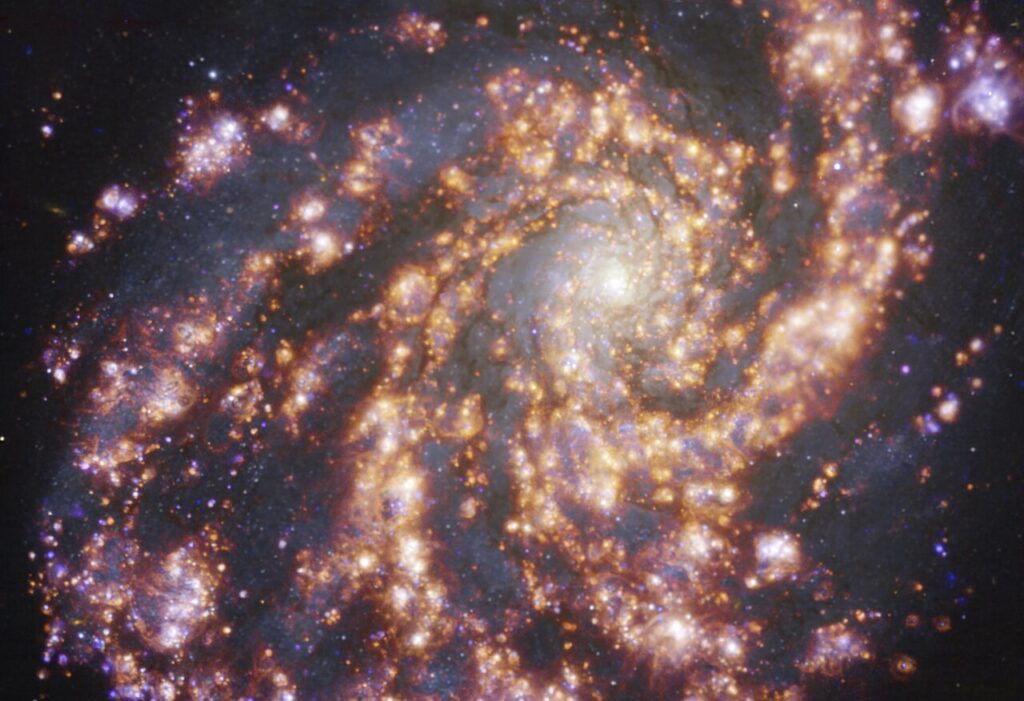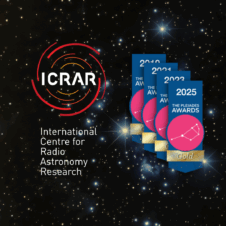Astronomers are exploring the mysteries of how stars are born.
Breathtaking images of galaxies close to the Milky Way have been released by an international team of astronomers exploring the mystery of how stars are born.
The amazing images, observed using telescopes operated by the European Southern Observatory in Chile’s Atacama Desert, show different components of the galaxies in distinct colours, allowing astronomers to pinpoint the locations of young stars and the gas they warm up around them. These stellar nurseries hold the secrets of how clouds of cold gas ignite to become stars.
To non-astronomers, the galaxies look like captured images of a beautiful fireworks display.

This image combines observations of the nearby galaxies NGC 1300, NGC 1087, NGC 3627 (top, from left to right), NGC 4254 and NGC 4303 (bottom, from left to right) taken with the Multi-Unit Spectroscopic Explorer (MUSE) on ESO’s Very Large Telescope (VLT). Each individual image is a combination of observations conducted at different wavelengths of light to map stellar populations and warm gas. The golden glows mainly correspond to clouds of ionised hydrogen, oxygen and sulphur gas, marking the presence of newly born stars, while the bluish regions in the background reveal the distribution of slightly older stars. The images were taken as part of the Physics at High Angular resolution in Nearby GalaxieS (PHANGS) project, which is making high-resolution observations of nearby galaxies with telescopes operating across the electromagnetic spectrum. Credit: ESO/PHANGS
Dr Rebecca McElroy from the Sydney Institute for Astronomy at the University of Sydney is part of the international research team.
“By combining observations from some of the world’s most powerful telescopes, we can examine the galactic regions where star formation is happening, compared to where it is expected to happen,” she said.
“This will give us a chance to better understand what triggers, boosts or holds back the birth of new stars,” she said.
Astronomers know that stars are born in clouds of gas, but what sets off their formation – and what role galaxies play in this – remains a mystery. To better understand this process, more than 90 scientists from 30 institutions around the world are observing nearby galaxies using powerful ground and space-based telescopes.
The work is part of the PHANGS (Physics at High Angular Resolution in Nearby GalaxieS) survey, which includes ESO’s Very Large Telescope (VLT) and the Atacama Large Millimeter/submillimeter Array (ALMA).

This image, taken by the Multi-Unit Spectroscopic Explorer (MUSE) on ESO’s Very Large Telescope (VLT), shows the nearby galaxy NGC 4303. NGC 4303 is a spiral galaxy, with a bar of stars and gas at its centre, located approximately 55 million light-years from Earth in the constellation Virgo. The image is an overlay of observations conducted at different wavelengths of light to map stellar populations and warm gas. The golden glows mainly correspond to clouds of ionised hydrogen, oxygen and sulphur gas, marking the presence of newly born stars, while the bluish regions in the background reveal the distribution of slightly older stars. The image was taken as part of the Physics at High Angular resolution in Nearby GalaxieS (PHANGS) project, which is making high-resolution observations of nearby galaxies with telescopes operating across the electromagnetic spectrum. Credit: ESO/ALMA (ESO/NAOJ/NRAO)/PHANGS
ALMA combines radio wavelength signals from 66 dish-shaped antennas, while the VLT consists of four large 8-metre telescopes and four smaller telescopes that can be used separately or combined into a single larger instrument.
A high-tech instrument attached to the Very Large Telescope called the Multi Unit Spectroscopic Explorer, or MUSE, was used for the recent observations.
MUSE collects spectra – the “bar codes” of light that astronomers scan to unveil the properties and nature of cosmic objects – at every single location within its field of view, providing much richer information than traditional instruments. For the PHANGS project, MUSE observed 30,000 clouds of warm gas and collected about 15 million spectra of different galactic regions.
“MUSE has given us an unprecedented view of what’s going on inside galaxies,” said Dr Brent Groves, a PHANGS team member from the University of Western Australia node of the International Centre for Radio Astronomy Research (ICRAR).

This image, taken with the Multi-Unit Spectroscopic Explorer (MUSE) on ESO’s Very Large Telescope (VLT), shows the nearby galaxy NGC 4254. NGC 4254 is a grand-design spiral galaxy located approximately 45 million light-years from Earth in the constellation Coma Berenices. The image is a combination of observations conducted at different wavelengths of light to map stellar populations and warm gas. The golden glows mainly correspond to clouds of ionised hydrogen, oxygen and sulphur gas, marking the presence of newly born stars, while the bluish regions in the background reveal the distribution of slightly older stars. The image was taken as part of the Physics at High Angular resolution in Nearby GalaxieS (PHANGS) project, which is making high-resolution observations of nearby galaxies with telescopes operating across the electromagnetic spectrum. Credit: ESO/ALMA (ESO/NAOJ/NRAO)/PHANGS
The ALMA observations allowed astronomers to map about 100,000 cold-gas regions across 90 nearby galaxies, producing an unprecedentedly sharp atlas of stellar nurseries in the close Universe. They include galaxies such as Messier 100, about 55 million light years from Earth, considered nearby in galactic terms.
“By combining these observations with those from ALMA, we’re able to see newborn stars while they’re still surrounded by the blanket of gas they’ve formed from,” Dr Groves said.
“The resulting images are absolutely stunning – they allow us a spectacularly colourful insight into the stellar nurseries of our neighbouring galaxies.”
In addition to ALMA and MUSE, the PHANGS project features observations from NASA’s Hubble Space Telescope. The various observatories were selected to allow the team to scan our galactic neighbours at different wavelengths (visible, near-infrared and sub-millimetre), with each wavelength range unveiling the distinct processes that occur across the observed galaxies.
The work carried out by the PHANGS project will be further developed by upcoming telescopes and instruments, such as NASA’s James Webb Space Telescope. The data obtained will lay further groundwork for observations with ESO’s future Extremely Large Telescope (ELT), which will start operating later this decade. This telescope will enable an even more detailed look at the structures of stellar nurseries.
EUROPEAN SOUTHERN OBSERVATORY
The European Southern Observatory is an astronomy organisation with 16 member states, along with the host country of Chile and Australia as a strategic partner. It plays a leading role in promoting and organising international research cooperation and provides state-of-the-art research facilities to astronomers.
In 2017 the Australian Government entered into a 10-year strategic partnership with ESO, as a pathway to potential full membership at the end of this period.
This unique partnership is giving Australian astronomers access to the world’s most advanced suite of optical telescopes and instruments, enabling research at the leading edge of discovery.
DOWNLOAD images of galaxies and the researchers at this link.
VIDEO links from the European Southern Observatory are available below
- Cosmic fireworks reveal newborn stars (ESOcast Light 239) (1m23s)
- Multiple views of galaxy NGC 4303 in different wavelengths (17s)
INTERVIEWS
Dr Rebecca McElroy | University of Sydney | rebecca.mcelroy@sydney.edu.au
Dr Brent Groves | ICRAR / University of Western Australia | brent.groves@icrar.org
MEDIA ENQUIRIES
Marcus Strom | University of Sydney | marcus.strom@sydney.edu.au | +61 423 982 485
Pete Wheeler | ICRAR | pete.wheeler@icrar.org | +61 423 982 018
Jess Reid | UWA | jess.reid@uwa.edu.au | +61 8 6488 6876

